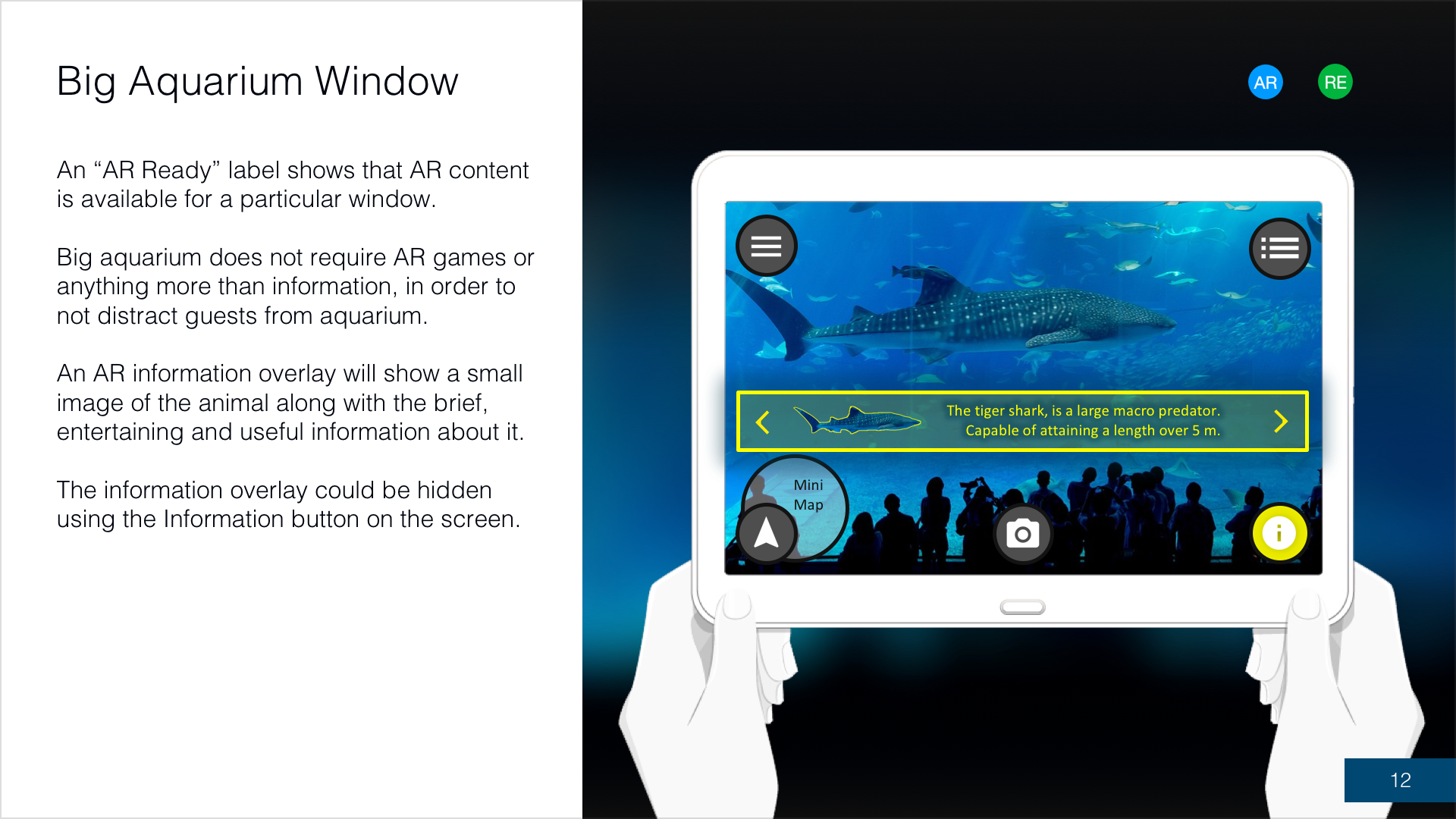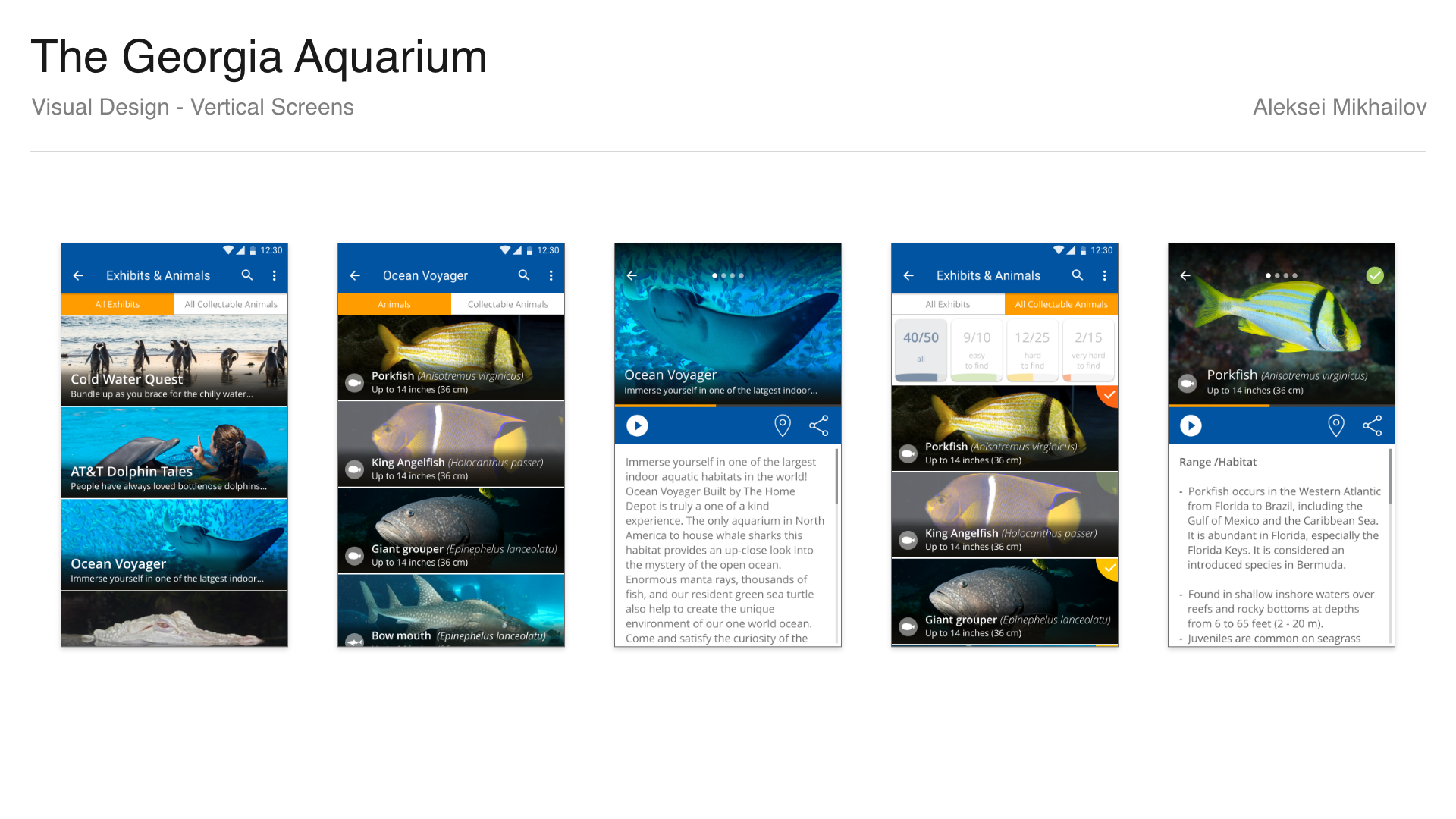Intro
Georgia Aquarium is a public aquarium in Atlanta, Georgia, United States. The aquarium exhibits hundreds of species and thousands of animals across its seven major galleries, all of which reside in more than 11 million US gallons (42,000 m3) of water. It was the largest aquarium in the world from its opening in 2005 until 2012 when it was surpassed by the S.E.A. Aquarium in Singapore and the Chimelong Ocean Kingdom in China; the Georgia Aquarium remains the largest aquarium in the United States and the sixth largest in the world.
Georgia Aquarium wanted to elevate visitors experience and make a visit more exciting and educative for guests of all ages, and to attract more visitors to the aquarium. As well as the initiative to reduce visitors reliance on paper-based maps and guides.
I was leading the reinvention efforts of the aquarium visitor's experience for Georgia Aquarium.


Final Designs
Design Concepts
On the first step of ideation and preparation of the design proposal, I've started with the research of modern technologies, new trends, and inspiration images boards.
Research on Modern Technologies
After a series of internal discussions, and collaborations, senior visual designer helped with character creation, which was included in the proposal later.
AR Story Characters Sketches
The next step was reviewing Georgia Aquarium current website, mobile app, and visitor experience. I've written down all the "pain points" with the proposal of how they may be solved. Then I've created personas, user stories, and initial low-fidelity wireframes for presentation.
I've compiled all the gathered information and created content into a proposal presentation, describing "A Day in the Aquarium" story for different personas:
• A day of employees at the aquarium;
• A family visit;
• A teacher and a class (school field trip) visit;
• After the visit (extended visitor's experience after leaving the aquarium).
• A day of employees at the aquarium;
• A family visit;
• A teacher and a class (school field trip) visit;
• After the visit (extended visitor's experience after leaving the aquarium).
The main challenge of the project was about how to fit all new extensive functionality into the existing app, and aquarium infrastructure. And make a seamless blending of digital and real worlds.



Presentation Slides
Topmost features that were included in the proposal were:
• Animal Recognition;
• Crowd Flow Control;
• AR Stories.
• Animal Recognition;
• Crowd Flow Control;
• AR Stories.
Animal Recognition feature, with the help of which visitors can recognize any animal in the aquarium.
Using a sophisticated Harman Heat Map technology, it would be easy to control the flow of visitor, to eliminate queues, organize events, and make visitor's experience more pleasant.
AR stories are the ideal blend of digital and real worlds, with which each visitor would have an entertaining, personal digital guide.



Presentation Slides
The purpose of AR stories was to guide, entertain, and educate visitors. Virtual characters, who can tell stories in different languages, would help to ease the pressure on aquarium workers and provide a personalized experience for visitors of all ages. Mini-games at the end of each exhibition would provide a learning experience through gamification.
For example, the game "Color the Sea Animal" educates kids, helps improve motor-skills and colored animal could be shared on a big TV screen, providing a socializing aspect of the visit.



Presentation Slides
Workshop and Research
After a workshop, on-site UX research, discussions with the development team and stakeholders initial scope was reduced to adding Animal Recognition feature to the existing app, and updating Animal's Gallery.
Georgia Aquarium - On-site UX Research
The biggest challenge was a new Animal Recognition feature, which was resolved by using a recurrent ANN (Artificial Neural Network) engine, which would be running on the user's smartphone or tablet.
The feature is also the initiative to reduce visitors reliance on paper-based maps and guides.
Design Delivery
I started creating UX Framework in Axure RP following Atomic Design approach, and using those blocks when creating all the detailed user flows and UX wireframes.


After UX wireframes were approved and finalized, I've started working on visual design and animations.


I've used Adobe XD for visual design and Adobe After Effects for animations.


UI Animations - Analyzing Photo, Animal Recognized
Results
Updated app was successfully launched in the Apple App Store and Google Play Store.
I've received a "Design Led Deal" award from Harman, and later the app won Digital Edge Award in 2018.
All screens, images, sketches, wireframes, visual designs, user experience designs, animations, industrial designs, 3D models, 3D model renders featured on this page are the intellectual property of the respective companies for which they were created. These works are showcased here for portfolio purposes only. All rights are reserved by the respective copyright owners. No part of this portfolio may be reproduced, distributed, or transmitted in any form or by any means, including photocopying, recording, or other electronic or mechanical methods, without the prior written permission of the copyright owner.